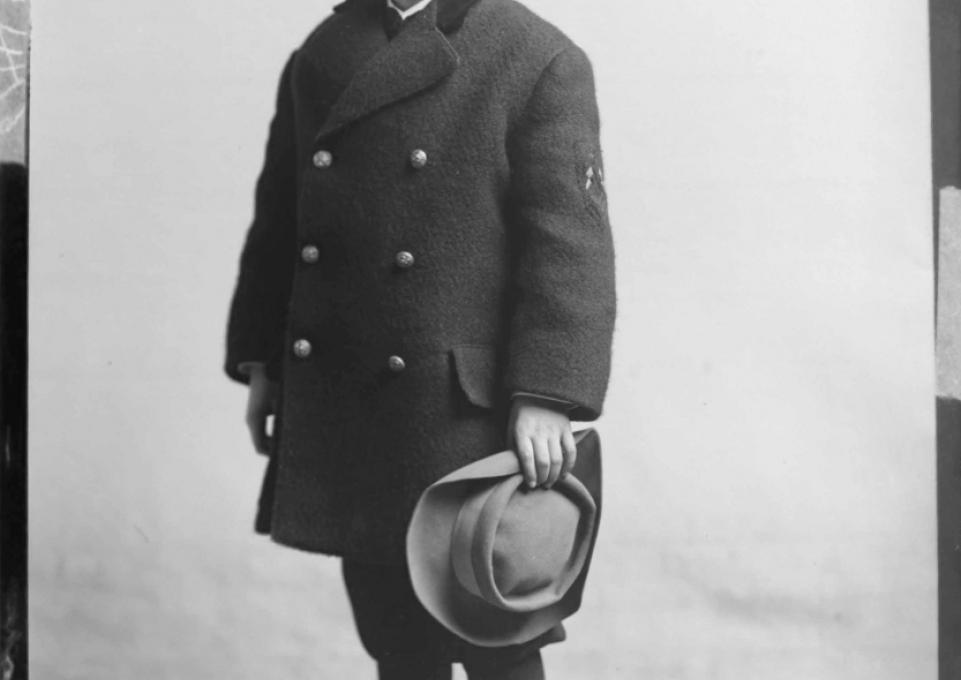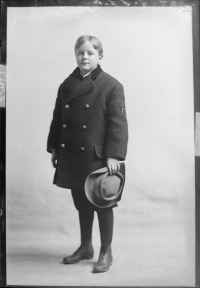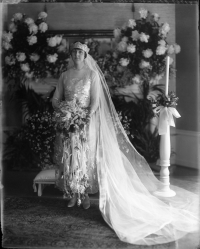
Fifty thousand dry plate glass negatives created by one of Buffalo’s most noted twentieth-century photographers is, in itself, a treasure trove. "But what’s wonderful about this gift is that we have all the files identifying the people in the photographs, as well as business ledgers, receipts, and personal letters," said Noelle Wiedemer, lecturer in the museum studies program.
 Photographer Howard D. Beach lived and worked at 469 Virginia Street. He had come to Buffalo to apprentice with photographer Andrew Simson in 1884; they became partners in 1896, and Beach took over the business in 1900. He established a lasting reputation for the photographs he took of Native Americans at the Pan-American Exposition in 1901. Beach worked into the 1940s, continuing to use dry glass plate negatives almost exclusively, according to Wiedemer.
Photographer Howard D. Beach lived and worked at 469 Virginia Street. He had come to Buffalo to apprentice with photographer Andrew Simson in 1884; they became partners in 1896, and Beach took over the business in 1900. He established a lasting reputation for the photographs he took of Native Americans at the Pan-American Exposition in 1901. Beach worked into the 1940s, continuing to use dry glass plate negatives almost exclusively, according to Wiedemer.
When local attorney Salvatore Giallombardo purchased the Virginia Street property, the negatives were still in the building’s basement, where Beach apparently had his darkroom. The Giallombardo family, recognizing the importance of both photographs and Beach’s records, donated them to the Buffalo History Museum in 2011.
Wiedemer is a chemist by training, an avid photographer, and owner of the Wide Angle Art Gallery in Medina. She was a graduate student in the museum studies program when the Buffalo History Museum acquired the Beach Collection, and it quickly became the focus of her graduate work. Now she uses the collection to give students hands-on experience as part of a graduate course she teaches, Digital Museum Collections.
This collaboration between Buffalo State and the Buffalo History Museum benefits both parties. "Last semester, students digitized more than 250 negatives," said Wiedemer, The process involves cleaning and vacuuming each glass negative, digitizing the image either by scanning it or by photographing the positive image using a light box, and finally rehousing each individual plate in an archival-quality envelope.
As the students work on digitizing the collection, they also pursue their own interests. One student looked for portraits of brides. "For something like that," Wiedemer explained, "you might pick a box containing photographs taken in June—something we can find because Beach kept such thorough records." Another student searched for photographs of soldiers in uniform. A student majoring in fashion technology looked for images showing styles from the eras documented by the collection.
One student investigated the link between people who were photographed by Beach and were later buried in Forest Lawn. "We found many examples of that," said Wiedemer. "Beach photographed many well-known Buffalonians—members of the Knox family, the Darwin D. Martin family, Ansley Wilcox, Katherine Cornell—even F. Scott Fitzgerald as an 11-year-old Buffalo resident."
 Although Beach’s subjects were mostly Western New Yorkers, his work was widely recognized. He received an honorary master of photography degree from the Photographers Association of America and exhibited his work in London in the 1928 group show Salon of the Royal Photographic Society of Great Britain, according to a biography published by Meibohm Fine Arts.
Although Beach’s subjects were mostly Western New Yorkers, his work was widely recognized. He received an honorary master of photography degree from the Photographers Association of America and exhibited his work in London in the 1928 group show Salon of the Royal Photographic Society of Great Britain, according to a biography published by Meibohm Fine Arts.
Wiedemer is particularly interested in researching Beach’s use of dry plate glass negatives. "We don’t have a lot of information about this technology," she said, "and yet it had significant advantages over wet plate glass photography, which has been studied extensively. Dry plate negatives could be stored for months before being developed—luxury photographers didn’t have with wet plate. This extensive, well-documented collection is a valuable resource for scholars studying the history and evolution of the art of photography."
Photos: Collection of the Buffalo History Museum
Top: F. Scott Fitzgerald, author of The Great Gatsby (1907)
Left: Florence Zeller, who married George Urban (1918)
